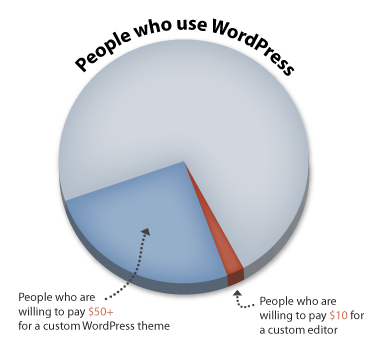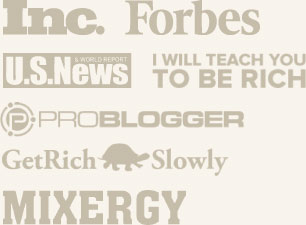Are You Thinking Big Enough with Your Business?
 You’ve spent hours working on your business concept, and you’ve figured out something people will pay you for. Congratulations!
You’ve spent hours working on your business concept, and you’ve figured out something people will pay you for. Congratulations!
Now, you may be inclined to jump head-first into creating a business. Lured by dreams of freedom and setting your own hours, you spend all of your free time researching a name and hammering out the details of getting people to your door.
But there’s a common problem that may trip you up and cause you to work long hours for low pay (not the most exciting prospect!) Here’s a good example of how that can happen, and what you can do to avoid this situation.
Recently, I had a chance to speak with Stephen Ou via email. He’s an up-and-coming entrepreneur who’s quite good at identifying problems others are having. He sent me an email asking whether I would use a new product he’s developing.
Stephen later posted an excellent blog post on his market research called “How I Got 38 Willing-to-Pay Customers Before Writing a Line of Code.” I love Stephen’s entrepreneurial spirit (especially considering he is only 16 years old!) But I noticed he has a thought process that is common with many talented first-time entrepreneurs: He’s not thinking big enough.
How many people can you serve, and how much will they pay? I see far too many entrepreneurs go after tiny markets and then charge too little to really make a difference. Follow this path, and you may end up working your buns off for a few hundred dollars a month in revenue…not a great place to be!
After reading Stephen’s blog post, I wrote him back and said:
“Cool, Stephen! I really like this. I just have one recommendation for you: Think bigger next time! You can use this same process to validate larger ideas. For instance, 10 people saying they are willing to pay for my new service, Whoosh Traffic, means a minimum of $1970/month in additional revenue for my business (and probably more.) So, how can you use this process for a product that will generate you thousands of dollars in revenue for each additional customer you bring to the table?”
Stephen wrote back with, “Great advice. It’s only my second time charging for a product–sometimes I always fear that when I charge too much, people will not see the value at the beginning. Therefore, it’s hard for it to go anywhere. Mind to share your thoughts on this?”
The Key to Your New Business: Breaking Down the Numbers
Let’s say you want to have a business that does a million dollars a year in revenue (a reasonable target–at this point, you will have employees, some work still on your hands, maybe a small office, and a pretty good salary.) Assuming you are charging $10 one-time, you need 100,000 customers a year–every year–to make that happen. That means you better be going after a market that a huge number of people are buying products in (office supplies, maybe, or cheap technology, or food.)
The problem is that many of those markets are commodity markets, where thousands of businesses are competing. The markets are crowded–you will need to find a real way to stand apart from the other companies selling similar goods. Plus you may need to support customers, and you won’t have much of a margin for that. What if other people want to sell your product as salespeople, affiliates, or distributors? You won’t have much room to pay them, and without incentives, they won’t be as motivated to sell for you. Most salespeople are not interested in selling a product for a $1 commission per product sold!
I’ve spoken about this to many entrepreneurs I see going down this path. And many will say, “But I don’t want a $1 million a year business.” If that’s you, that’s fine–but I do take a hard stance against going for a small market anyway. It’s not worth burning yourself out for less than minimum wage–an unfortunate position that many business owners are stuck in because they picked a market that just wasn’t that big.
My Criteria for Starting a Business
I have three major criteria that I look for when I start any new business:
1) The business must be something that I don’t have to explain to people–something that people easily understand. The value proposition for Whoosh Traffic, for instance, is compelling: Get more traffic to your website. That’s something that a huge proportion of businesses with websites need. It’s better to start off with a big market and then narrow it down than to start off with a small market filled with only a handful of people.
2) It’s something I can charge a lot of money for and have a relatively small customer base to be successful. When I sold my hosting company for $1.1 million, we only had 161 customers. But they were paying us an average of $425/month. That’s over $800,000/year in revenue from a small customer base. I didn’t need 80,000 customers to make that work (or 6,667 shared hosting customers paying us $10/month in revenue…can you imagine the support nightmare for that customer base?)
3) It’s scalable and systematizable. I don’t want to get into a situation where my expertise is the only “glue” holding my business together. I want any business I create to be sellable, and that means I have to create systems that other people I employ can follow, and gradually pull myself out of the business.
With Whoosh Traffic, our minimum service level is $197/month, and 55% of our customers opt for a more expensive package. Our average monthly revenue per customer (since we changed our pricing plans) is $365.73/month. That means we only need 228 customers to hit the $1 million mark. And our projections show us hitting 7 figures of annual revenue in under 2 years of being open.

Infographic by Brian Fryer.
Here’s an example of a known 7-figure business in Stephen’s niche: Premium WordPress themes. WooThemes, one of the most popular premium theme providers, now makes over $2 million/year–and their business meets the criteria I outlined above. (Note: The percentages in the above infographic are not accurate, as I couldn’t find real data on how many bloggers choose to opt for a premium WordPress theme. However, it does show the relative size of the markets in the WordPress arena.)
How Big is Your Market?
When picking out what type of business to start, seriously consider how big your market is. And instead of trying to create a market out of thin air, why not take a huge market, go for the high end of it, and pull a nice chunk out of it for yourself? Go where the money is, and sell something where there is clear, proven demand.
Also–I cannot recommend highly enough to sell a premium product and then deliver with amazing customer service. It is so much easier to support 10 customers than 10,000. And if 10 customers pays all your bills and allows you the freedom you desired when you started your business, do that. Find customers who do see the value in what you offer, and charge them appropriately. There are very few entrepreneurs who started out charging a lot and then regretted it–however, there are a lot of business owners who charge too little and now feel stuck with their businesses.
Charge more, find a way to take your business into the monthly sphere, and then overdeliver with amazing customer support, and you’ll hit your revenue and profit goals much more quickly!
Recommended Reading:
- Artsy Editor. Stephen has been a great sport at letting me use him as an example for this blog post. If you’re tired of WordPress’s default editor and its cluttered feature set, check out his awesome new product, Artsy Editor.
- How to Choose a Business. The story of how (and why) I chose web hosting as my first big business, and more criteria I look for when starting a business.
- How To Start A Business With No Money. How to get started even if you’re not sitting on piles of cash.


